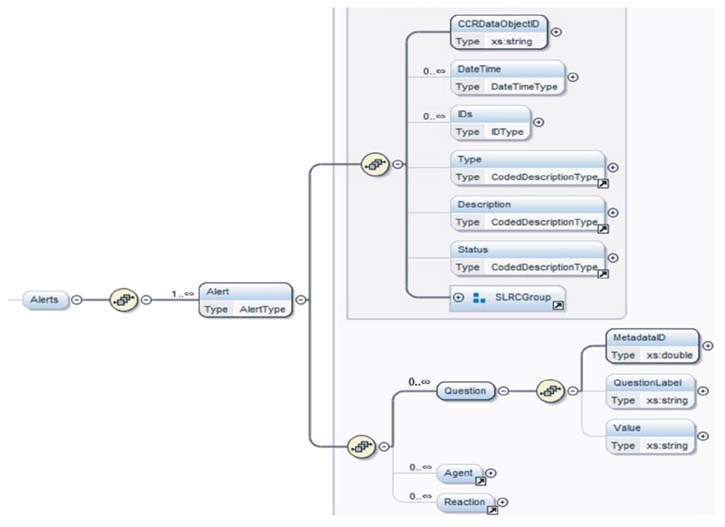Healthc Inform Res.
2014 Jan;20(1):39-44. 10.4258/hir.2014.20.1.39.
CCR+: Metadata Based Extended Personal Health Record Data Model Interoperable with the ASTM CCR Standard
- Affiliations
-
- 1Department of Biomedical Informatics, Asan Medical Center, Seoul, Korea.
- 2Seoul National University Biomedical Informatics (SNUBI), Seoul National University College of Medicine, Seoul, Korea. juhan@snu.ac.kr
- 3Medical Informatics, Graduate School of Public Health, Gachon University of Medicine and Science, Incheon, Korea.
- 4Division of Biomedical Informatics, Seoul National University College of Medicine, Seoul, Korea.
- KMID: 2166737
- DOI: http://doi.org/10.4258/hir.2014.20.1.39
Abstract
OBJECTIVES
Extension of the standard model while retaining compliance with it is a challenging issue because there is currently no method for semantically or syntactically verifying an extended data model. A metadata-based extended model, named CCR+, was designed and implemented to achieve interoperability between standard and extended models.
METHODS
Furthermore, a multilayered validation method was devised to validate the standard and extended models. The American Society for Testing and Materials (ASTM) Community Care Record (CCR) standard was selected to evaluate the CCR+ model; two CCR and one CCR+ XML files were evaluated.
RESULTS
In total, 188 metadata were extracted from the ASTM CCR standard; these metadata are semantically interconnected and registered in the metadata registry. An extended-data-model-specific validation file was generated from these metadata. This file can be used in a smartphone application (Health Avatar CCR+) as a part of a multilayered validation. The new CCR+ model was successfully evaluated via a patient-centric exchange scenario involving multiple hospitals, with the results supporting both syntactic and semantic interoperability between the standard CCR and extended, CCR+, model.
CONCLUSIONS
A feasible method for delivering an extended model that complies with the standard model is presented herein. There is a great need to extend static standard models such as the ASTM CCR in various domains: the methods presented here represent an important reference for achieving interoperability between standard and extended models.
Keyword
Figure
Cited by 1 articles
-
Health Avatar: An Informatics Platform for Personal and Private Big Data
Ju Han Kim
Healthc Inform Res. 2014;20(1):1-2. doi: 10.4258/hir.2014.20.1.1.
Reference
-
1. Brusse B, Wenning R. Benefits of standards and standardization [Internet]. Brussels, Belgium: COPRAS;c2010. cited at 2013 Nov 13. Available from: http://www.w3.org/2004/copras/docu/D15.html#benefits.2. Brazma A, Hingamp P, Quackenbush J, Sherlock G, Spellman P, Stoeckert C, et al. Minimum information about a microarray experiment (MIAME)-toward standards for microarray data. Nat Genet. 2001; 29(4):365–371.
Article3. HL7: an application protocol for electronic data exchange in healthcare environments (HL standard ver. 2.3.1.). Ann Arbor (MI): Health Level Seven;1999.4. Smith B, Ceusters W. HL7 RIM: an incoherent standard. Stud Health Technol Inform. 2006; 124:133–138.5. Jing X, Kay S, Marley T, Hardiker NR, Cimino JJ. Incorporating personalized gene sequence variants, molecular genetics knowledge, and health knowledge into an EHR prototype based on the Continuity of Care Record standard. J Biomed Inform. 2012; 45(1):82–92.
Article6. Spyropoulos B, Botsivaly M, Tzavaras A, Koutsourakis K. Extending the use of DRGs to estimate mean Home-Care cost by employing an adapted ASTM E2369-05 Continuity of Care Record. Conf Proc IEEE Eng Med Biol Soc. 2006; 1:5210–5213.
Article7. Park YR, Lee HW, Cho SB, Kim JH. Cancer genomics object model: an object model for multiple functional genomics data for cancer research. Stud Health Technol Inform. 2007; 129(Pt 2):1235–1239.8. Park YR, Yoon YJ, Kim HH, Kim JH. Establishing semantic interoperability of biomedical metadata registries using extended semantic relationships. Stud Health Technol Inform. 2013; 192:618–621.9. Park YR, Kim JH. Achieving interoperability for metadata registries using comparative object modeling. Stud Health Technol Inform. 2010; 160(Pt 2):1136–1139.10. Jones A, Hunt E, Wastling JM, Pizarro A, Stoeckert CJ Jr. An object model and database for functional genomics. Bioinformatics. 2004; 20(10):1583–1590.
Article11. Wolf KH, Schirmer S, Marschollek M, Haux R. Representing sensor data using the HL7 CDA personal healthcare monitoring report draft. Stud Health Technol Inform. 2009; 150:480–484.12. Veseli H, Kopanitsa G, Demski H. Standardized EHR interoperability: preliminary results of a German pilot project using the archetype methodology. Stud Health Technol Inform. 2012; 180:646–650.13. Do NV, Barnhill R, Heermann-Do KA, Salzman KL, Gimbel RW. The military health system's personal health record pilot with Microsoft HealthVault and Google Health. J Am Med Inform Assoc. 2011; 18(2):118–124.
Article14. American Dental Association. Dental extension to the ASTM Continuity of Care Record. Chicago (IL): American Dental Association;2008. (ANSI/ADA Standard No. 1040).15. ASTM International. Standard specification for Continuity Of Care Record (CCR). West Conshohocken (PA): ASTM International;2005. (ASTM E2369).16. International Organization for Standardization. Information technology: metadata registries (MDR). Part 3. Registry metamodel and basic attributes. Geneva: International Organization for Standardization;2003. (ISO/IEC 11179-3:2003).17. Sinaci AA, Laleci Erturkmen GB. A federated semantic metadata registry framework for enabling interoperability across clinical research and care domains. J Biomed Inform. 2013; 46(5):784–794.
Article18. Blobel B. EHR architectures - comparison and trends. Stud Health Technol Inform. 2008; 134:59–73.19. Park YR, Kim H, An EY, Kim HH, Kim JH, Park RW, et al. Establishing semantic interoperability in the course of clinical document exchange using international standard for metadata registry. J Korean Med Assoc. 2012; 55(8):729–740.
Article
- Full Text Links
- Actions
-
Cited
- CITED
-
- Close
- Share
- Similar articles
-
- DialysisNet: Application for Integrating and Management Data Sources of Hemodialysis Information by Continuity of Care Record
- Estimation of Renal Function from Perfusion Images of Tc-99m DTPA Renal Scan
- Percentage of Korean CAPD patients meeting DOQI guidelines - Analyzed using the computerized urea kinetic modeling -
- Review of Semantically Interoperable Electronic Health Records for Ubiquitous Healthcare
- Development of Health Information Search Engine Based on Metadata and Ontology



